I shall not mince my words: after an excursion to some beautiful place in the mountains or in the countryside, I usually find it hard to cope with the mundaneness of every day life once I am back in the city and I am stuck with my daily routine – even though I must acknowledge that we are extremely lucky to be living on the outskirts of Lausanne (population of only 140,000) and that we are bestowed with a beautiful view of the lake (which is enough to give me the impression that I am on holiday whenever I take the time to admire this expanse of blue, grey and green that stretches over the horizon almost right opposite the windows of our flat).
In between the last excursion and the next one, there is always this strong longing for the type of beautiful scenery, nice weather and fresh air that we got to experience on our previous outing. This feeling may linger long in the mind, especially if the weather turns bad…
 [From a vantage point close to ‘Remointse d’Arolla’, 2400m, 14 September 2014; click to enlarge]
[From a vantage point close to ‘Remointse d’Arolla’, 2400m, 14 September 2014; click to enlarge]
A month ago, we went to Valais/Wallis to meet up with a good friend of mine. Together with his father and my wife, we set off to the pass of the goats (‘Pas de Chèvres’) on the slopes of the mountain of Arolla. Even though my wife and I did not make it up to there, we got to admire breathtaking views as well as we got to enjoy being in the open on a beautiful day.
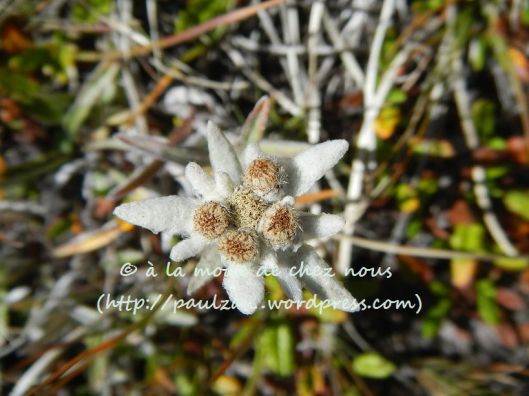 [Star of the alps, the edelweiss]
[Star of the alps, the edelweiss]
On our way down, we came across this beautiful flower, the edelweiss, which was enough to make up for our failed attempt at reaching the pass. In all, we spotted a dozen of these beauties, which of course we refrained from picking as edelweiss are rare — in fact, it is forbidden to do so as they are a protected species.
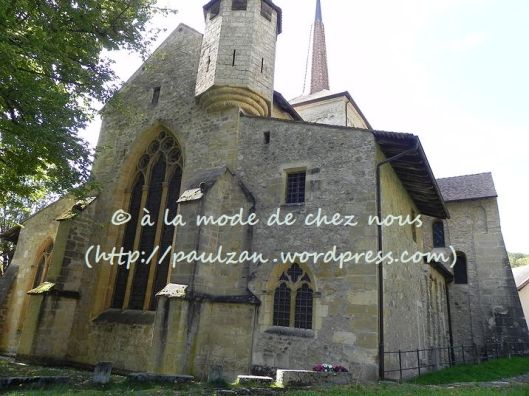 [Abbey church of Romainmôtier, as seen from the east, 28 September 2014]
[Abbey church of Romainmôtier, as seen from the east, 28 September 2014]
Two weeks later, we decided to make use of the really gorgeous weather we were having to visit Romainmôtier, a village that nestles in a small valley at the foot of the mountain chain called Jura. This place is famous for its abbey church, probably the oldest in Switzerland and one that was modelled after that of Cluny, in France.
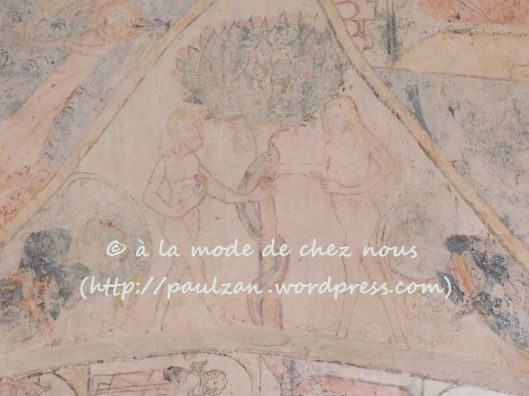 [A famous scene from the Old Testament in the narthex]
[A famous scene from the Old Testament in the narthex]
I am very fond of Romainmôtier and its very old church – the main walls are more than a thousand years old and the architectural style, called Romanesque, is one that I find particularly attractive as the purity of form characteristic of this type of architecture makes the building a place propitious to spiritual elevation. Even though I had visited the village and the abbey church on two prior occasions, there were still many ‘treasures’ left to discover or rediscover – for instance, the magnificent paintings in the narthex [Encyclopædia Britannica definition here], which were probably painted in the 14th century and which had been concealed by the Bernese under a thick layer of lime plaster during the Reformation.
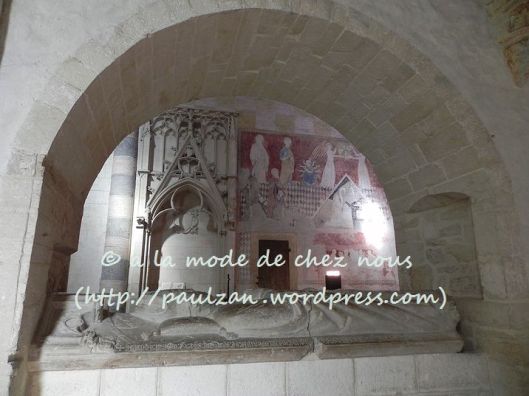 [Painted wall of the choir of the abbey church of Romainmôtier]
[Painted wall of the choir of the abbey church of Romainmôtier]
I sat almost smack on the south-west corner of the crossing (the area where the nave and the transept cross each other), in what had been the choir of the very first church built on this site, some 1,500 years ago, for about 15 minutes. No wonder then that I felt the place to be so soothing — even if geobiologists like Blanche Merz place the point with the maximum energy a little ahead, in the forechoir (Haut-lieux cosmo-telluriques, Geneva, Georg Librairie de l’Université, 1983, page 154).
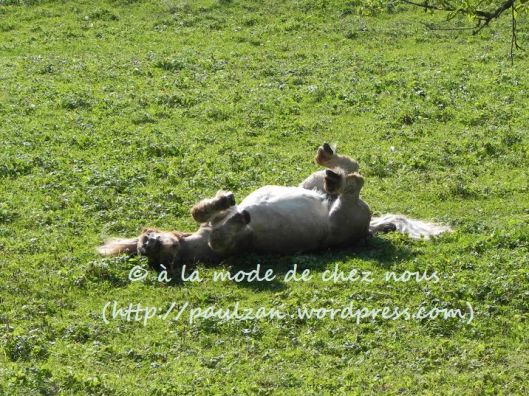 [Pony in a field, along the first stretch of ‘sentier du patrimoine’, in between Romainmôtier and Croy]
[Pony in a field, along the first stretch of ‘sentier du patrimoine’, in between Romainmôtier and Croy]
Then it was time to make our way towards the village of Croy for the second part of our excursion: a visit to the waterfall of ‘Dard’ (‘sting’) as I was also interested in putting to the test Blanche Merz’s assertion that waterfalls radiate positive energy. 😉 As we walked along the beautiful ‘heritage path’ (‘sentier du patrimoine’ in French), we spotted this pony that was rolling itself in the grass. This animal was so funny and it was really a pleasure to think that he was enjoying himself too.
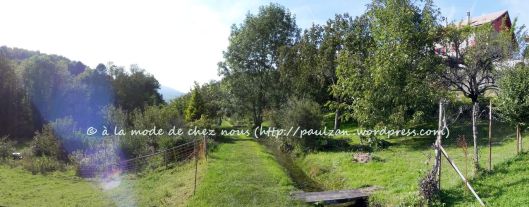 [Fruit trees along ‘sentier du patrimoine’, near the village of Croy]
[Fruit trees along ‘sentier du patrimoine’, near the village of Croy]
On our way, we saw innumerable fruit trees, most of which made my wife (a keen forager) green with envy (so as to speak). The area of Romainmôtier-Croy has managed to preserve its rural heritage in part because farming still seems to be an important economic activity. Let us hope that this remains the case as long as possible and that the villages of Romainmôtier and Croy do not end up as a posh residential area for non-locals holding white-collar jobs in Lausanne, Vallée de Joux, Orbe, Yverdon or wherever else.
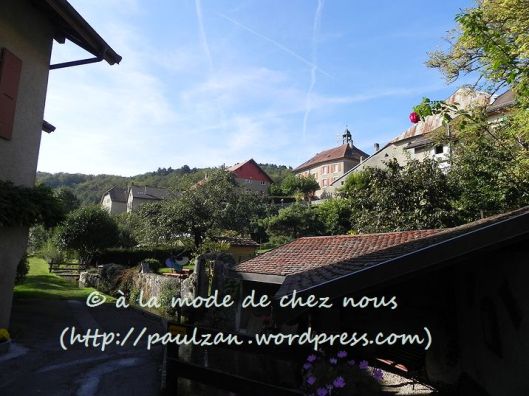 [Laundry area along the river Nozon with village of Croy]
[Laundry area along the river Nozon with village of Croy]
Towards the end of the second stretch of the ‘heritage path’, we saw the second ‘lavoir’ , the area where the women of the village would wash their linen by battering the dirt out of the fabric of the garments in the running water. How nice it must have been to live in an age where there were no man-made and harmful chemicals (the only detergent they had was some ‘savon de Marseille’, which was 100% natural – click here to find out more about this soap).
A leisurely stroll along the fields of a part of the countryside nicknamed ‘La Foule’ (crowd in English) for half an hour or so and then through some wood, and, finally, I was standing in front of a waterfall I had wanted to see for many, many years. Some twelve metres high, the waterfall of ‘Dard’, located at the ‘gorge’ of the small river ‘La Nozon’ (which flows under the abbey church and which we had followed more or less without interruption since we had stepped out of the church), is probably not as impressive as some of the more famous waterfalls in Switzerland or elsewhere, but it was certainly tall enough to come crashing down with full force and thus provide a nice sensation of freshness on what was a unusually warm afternoon on the first weekend of autumn 2014. As to whether this waterfall has a very high positive energy content, this is something I cannot answer, probably because I had already taken in as much as I could while I was sitting in the very first choir of l’abbatiale de Romainmôtier. 😉
What a beautiful day it was. I was able to get my wife to enjoy a haven of ‘Swissness’: a pristine rural landscape (with plenty of fruit trees) and a small village which has retained its character and farming essence with teenagers who say hello (spontaneously) to strangers, delicious fruit tarts to be eaten near the abbey church, itself a listed building more than a thousand years old and which is strong in spirituality and character … in short, what a better way to spend a beautiful sunny afternoon on the first Sunday of autumn? Especially since ‘Tempus fugit’ (time flies) as the inscription above a sundial in the village of Croy is there to remind passers-by. So I definitely look forward to making the most of this coming weekend. 😉
Links
- Running on ski slopes … part 1 (account of a running trip to ‘Pas de Chèvres’ on the slopes of the mountain of Arolla)
- ‘De Lausanne à Romainmôtier à bicyclette pour célébrer l’arrivée de l’automne’ (account of my cycling trip to Romainmôtier, in French)
- Star of the alps … the edelweiss … (wife’s account of the Arolla excursion with some really great pictures of edelweiss)
- The mountains of Arolla … in summer … (wife’s account of the Arolla excursion with some great pictures of the area)
- A visit to Romainmôtier … (wife’s account of this excursion with lots of nice pictures!)

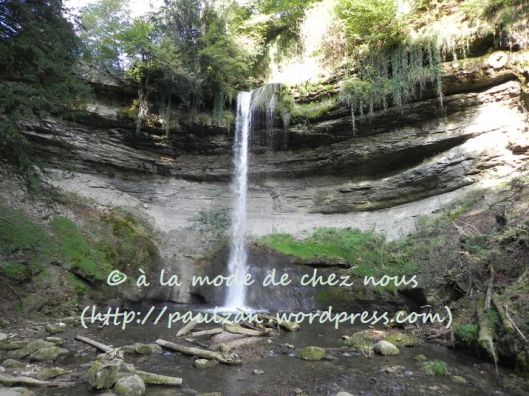
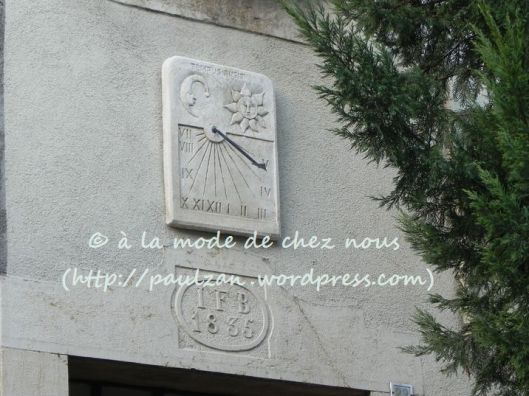
Pingback: A visit to Romainmôtier … | Just Sharing